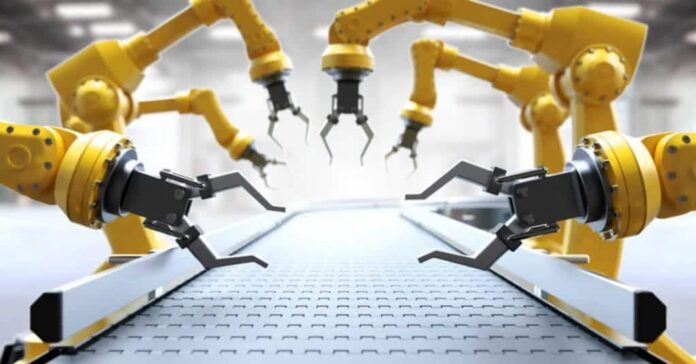The manufacturing sector has witnessed the growing adoption of robotic engineering and technology in its production processes due to rapid technological developments in robotics. Automatically operated, reprogrammable, and multipurpose manipulator devices are industrial robots. Welding, painting, ironing, assembly, pick and place, palletizing, product inspection, and testing are typical applications of industrial robots, all performed with high endurance, speed, and precision. Industrial robots carry out activities that are repeatable and save human labor. Also, industrial robots can operate in unsafe and dangerous conditions in which humans can not participate. The US, China, Japan, South Korea, and Germany alone account for 70 percent of the global market volume of industrial robots. Since 2010, global investments made in industrial robots by the automotive industry have increased significantly. The demand for industrial robotics has increased by double digits since 2012 and will continue to expand at least through 2021, according to a McKinsey survey. We can not predict how the market will shape precisely in the future, but we can monitor the developments in industrial robotics that will drive the transition.
The Industrial Internet of Things (IIoT), also known as Industry 4.0, is changing the way businesses, especially industrial companies, operate dramatically. The IIoT refers to a large number of computers and devices that are now connected to the internet or products that an organization uses. In the vast technology that has numerous consequences in the industrial robotics field, there are infinite applications. Remarkably, smart sensors and actuators at the edge of development are expected to be gradually deployed by robots. IIoT leverages the strength of real-time analytics and smart machines to take advantage of the data through its specialized use cases.
Collaborative robots or cobots are a form of robotic automation designed to operate in a shared, collaborative workspace safely alongside human employees. It is the duty of a collaborative robot for repeated and menial tasks that might tire people. It also stops workers in the sector from going into essential and hazardous jobs. Collaborative robot’s functionalities primarily vary in industrial radar compared to other industries. With advanced sensors and software, industrial collaborative robots are designed to detect and respond to any human intrusion into their workspace.
A robot that can communicate with the world around them is one of the main characteristics that industrial robotics is looking for. Researchers and scientists have used advanced sensing and gripping technologies in industrial robots to make this long imagination a reality. Tools such as force control and advanced 2-D and 3-D vision, when combined with powerful processing capabilities, can establish a kind of robotic independence and enable the robot to make decisions about what to do when it encounters the inevitable problems that occur in daily activity.
Industrial robots that can communicate with each other independently of human support are increasingly seen as an ability to fast-track manufacturing. As part of Industry 4.0, industrial robots are the core components of automated and networked manufacturing. The ‘OPC Robotics Companion Specification’ was created by a group of researchers working at VDMA and Open Platform Communications Foundation (OPC). This mechanism allows industrial robots to link to the Industrial Internet of Things (IIoT).

